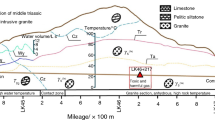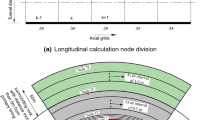Abstract
Forced ventilation is a common means to solve the problem of high ambient temperature during the construction of high-ground-temperature tunnels. In forced ventilation, it is very important to prevent the fresh cold airflow from being heated by the high-ground-temperature environment when it reaches the working surface so as to ensure the cooling effect. Based on heat transfer theory, a temperature numerical calculation model is proposed for forced ventilation in high-ground-temperature tunnels that considers the convection heat transfer between the airflow inside the duct, and the airflow inside the tunnel and the surrounding rock, combined with the influence of the duct leakage rate. This model compensates for the lack of considering the surrounding rock temperature and the duct leakage rate in relevant studies. Using the 7# cross tunnel of an actual tunnel as a case study, the effects of ventilation volume, construction distance and thermal insulation duct on the airflow temperature inside the duct and tunnel were investigated. According to the field test results, the developed numerical calculation model is in good agreement with field test data, with a maximum difference of 2 °C between the numerical calculation results and field test data. The thermal insulation duct has good thermal insulation performance. Under different construction distances, the thermal insulation duct can reduce the airflow temperature at the outlet of the duct by 6–14 °C, up to as much as 28–40%. Simply increasing the ventilation volume has no significant effect on preventing the airflow temperature rise inside the duct. At the same construction distance, although the airflow temperature at the duct outlet gradually decreases with the increase in the ventilation volume, the decrease is small: For every 10 m3 s−1 increase in the ventilation volume, the temperature is only reduced by 1 °C. For a tunnel with short construction distance and low surrounding rock temperature, the requirements can be met without thermal insulation treatment of the duct, but for a long-distance tunnel, the thermal insulation duct is an effective and economical auxiliary cooling means.









Similar content being viewed by others
References
Ministry of Railways of the People’s Republic of China. Code for design on operating ventilation of railway tunnel. In: TB10068-2010. Beijing: China Railway Press; 2010. (in Chinese).
Zeng YH, Tao LL, Ye XQ, Zhou XH, Fang Y, Fan L, Liu XR, Yang ZX. Temperature reduction for extra-long railway tunnel with high geotemperature by longitudinal ventilation. Tunn Undergr Space Technol. 2020;99:103381. https://doi.org/10.1016/j.tust.2020.103381.
Zhu Y, Zhou JM, Wang SS, Li L. Numerical simulation of ice cooling in tunnel construction with high geotherm in tropical area: a case study of Wuzhishan highway tunnel in Hainan, China. Tunn Constr. 2020;40:1742–7 (in Chinese).
Srinavin K, Mohamed S. Thermal environment and construction workers’ productivity: some evidence from Thailand. Build Environ. 2003;38:339–45. https://doi.org/10.1016/S0360-1323(02)00067-7.
Hu YP, Wang MN, Wang QL, Liu DG, Tong JJ. Field test of thermal environment and thermal adaptation of workers in high geothermal tunnel. Tunn Undergr Space Technol. 2017;66:134–46. https://doi.org/10.1016/j.buildenv.2019.106174.
Li HW, Bao XY. Risk assessment of Qinghai-Tibet Plateau traffic engineering high geothermal tunnel construction based on dynamic weight and 2D cloud model. Eng J Wuhan Univ. 2022;55:1010–8 (in Chinese).
Zhang GL, Jiang ZA, Wang H, Jing XP, Si ML, Zeng FB, Yang B, Yang XD, Feng R. The coupled cooling effect of ventilation and spray in the deep-buried high-temperature tunnel. Case Stud Therm Eng. 2023;45:103011. https://doi.org/10.1016/j.csite.2023.103011.
Wang F, Luo FY, Huang YB, Zhu L, Hu H. Thermal analysis and air temperature prediction in TBM construction tunnels. Appl Therm Eng. 2019;158:113822. https://doi.org/10.1016/j.applthermaleng.2019.113822.
Duan LM, Zhang YH, Lai JX. Influence of ground temperature on shotcrete-to-rock adhesion in tunnels. Adv Mater Sci Eng. 2019;2019:1–16. https://doi.org/10.1155/2019/8709087.
Chen X, Zhou XH, Zhong ZL, Liang NH, Wang Y, Zhang XY. Study on temperature field and influencing factors of the high geothermal tunnel with extra-long one-end construction ventilation. Int J Therm Sci. 2023;191:108322. https://doi.org/10.1016/j.ijthermalsci.2023.108322.
Zhou XH, Ren XC, Ye XQ, Tao LL, Zeng YH, Liu XR. Temperature field and anti-freezing system for cold-region tunnels through rock with high geotemperatures. Tunn Undergr Space Technol. 2021;111:103843. https://doi.org/10.1016/j.tust.2021.103843.
Tao LL, Ren XC, Zhao DX, Zeng YH, Zhou XH. Numerical study on effect of natural wind and piston wind on anti-freezing length of tunnels with high geo-temperature in cold region. Int J Therm Sci. 2022;172:107372. https://doi.org/10.1016/j.ijthermalsci.2021.107372.
Sun SB, Yan SH, Cao XP, Zhang W. Distribution law of the initial temperature field in a railway tunnel with high rock temperature: a model test and numerical analysis. Appl Sci Basel. 2023;13:1638. https://doi.org/10.3390/app13031638.
Tao LL, Tian XY, Zhou XH, Zeng YH. Influence of mechanical wind heated by ground temperature on ambient temperature in tunnels: numerical modeling, case study and analysis. Int J Therm Sci. 2022;176:107497. https://doi.org/10.1016/j.ijthermalsci.2022.107497.
Zhang GZ, Cao ZM, Wang W, Mei XS, Zhao X, Shen SW, Na TX. Field test and numerical investigation on thermal environment of tunnel with air layer structure. Build Environ. 2021;203:108105. https://doi.org/10.1016/j.buildenv.2021.108105.
Guan PP, Cheng JW, Zhu S, Zhang YL. Development and application of thermal insulation material for underground roadway with high ground temperature. Energy Sources Part A Recov Util Environ Eff. 2023;45:1499–510. https://doi.org/10.1080/15567036.2023.2179692.
Liu XC, Huang F, Zhou Y, Yang D, Hu Z. Optimization of insulation layer thickness and analysis of lining response under thermal–mechanical coupling in high temperature tunnels. Mod Tunn Technol. 2022;59:108–17 (in Chinese).
Zhou XH, Zeng YH, Yang ZX, Zhou XJ. Numerical solution of temperature field in high ground temperature tunnel. J Railw Sci Eng. 2015;12:1406–11 (in Chinese).
Chen Q, Zhang H, Zhu YM, Chen SG, Ran GY. Study on distributions of airflow velocity and convective heat transfer coefficient characterizing duct ventilation in a construction tunnel. Build Environ. 2021;188:107464. https://doi.org/10.1016/j.buildenv.2020.107464.
Zhang GL, Jiang ZG, Chen JH, Chen JW, Yang B. Study of the convection heat transfer law and temperature prediction of the duct in high-temperature tunnels. Case Stud Therm Eng. 2022;36:102208. https://doi.org/10.1016/j.csite.2022.102208.
Wang Z, Zhang L. Application of calculation method for ventilation and cooling in thermal environment of Gaoligongshan tunnel construction. Tunn Constr. 2020;40:144–50 (in Chinese).
Wang YP. Case study on ventilation and cooling control technology of multi heat source coupling in long distance subsea tunnel construction. Case Stud Therm Eng. 2021;26:101061. https://doi.org/10.1016/j.csite.2021.101061.
Zhang GZ, Cao ZM, Xiao SG, Guo YM, Li CL. A promising technology of cold energy storage using phase change materials to cool tunnels with geothermal hazards. Renew Sustain Energy Rev. 2022;163:112509. https://doi.org/10.1016/j.rser.2022.112509.
Li CL, Zhang GZ, Xiao SG, Xie YL, Liu XH, Cao SD. Long-term operation of tunnel-lining ground heat exchangers in tropical zones: energy, environmental, and economic performance evaluation. Renew Energy. 2022;196:1429–42. https://doi.org/10.1016/j.renene.2022.07.003.
Zhang Y, Xia CC, Zhou SW, Hu YJ, Zhang JX. A new sustainable energy based freeze proof method for drainage system in cold-region tunnels: a case study of Tianshan Shengli Tunnel. Case Stud Therm Eng. 2022;34:102020. https://doi.org/10.1016/j.csite.2022.102020.
Zhang GZ, Guo YM, Zhou Y, Ye MX, Chen RF, Zhang HL, Yang JD, Chen JW, Zhang MH, Lian YJ, Liu CY. Experimental study on the thermal performance of tunnel lining GHE under groundwater flow. Appl Therm Eng. 2016;103:784–95. https://doi.org/10.1016/j.applthermaleng.2016.06.041.
Wei B, Xie Y, Zhang GZ, Li CL. Numerical study on long-term performance of ground source heat pumps with tunnel lining heat exchangers. J Shenzhen Univ Sci Eng. 2022;39:36–41 (in Chinese).
Zhang GZ, Zhang XQ, Xia CZ, Yang Y. The construction of a geothermal energy based tunnel heating system. Mod Tunn Technol. 2015;52:170–6 (in Chinese).
Yan J, He C, Zeng YH, Wang B, Zhang JB. Cooling technology and effect analysis for high geothermal tunnel on Sichuan-Tibet railway. China Railw Sci. 2017;40:53–62 (in Chinese).
Qiao HY. Research on cooling and thermal environment of super-long single-headed tunnel construction with high ground temperature. Chin J Undergr Space Eng. 2023;19:632–9 (in Chinese).
Zhou JM, Shen WJ, Zhu Y, Fan J, Yin JG, Wu Q. Research on ice block cooling technology during railway tunnel construction. China Saf Sci J. 2022;32:44–52 (in Chinese).
Tan XJ. Study on the mechanism of frost heave of tunnel in cold region with high altitude and related insulation technology. Wuhan: Graduate School of Chinese Academy of Sciences (Wuhan Institute of Geotechnics); 2010. (in Chinese).
Zeng YH, Yao WH, Tian XY, Fan L, Liu X. Calculation method for tunnel air duct leakage based on static pressure variation. China Railw Sci. 2023;44:134–41 (in Chinese).
Wang XL, Zhang ZQ, Zhou ZY, Chen HC. Numerical simulation of TBM construction ventilation in a long diversion tunnel. Tunn Undergr Space Technol. 2011;26:560–72. https://doi.org/10.1016/j.tust.2011.03.001.
Li Q, Yu L, Yan T, Liu X, Wang M. Study on construction ventilation duct leakage rate in high altitude tunnel. J China Railw Soc. 2019;41:144–8 (in Chinese).
Versteeg HK, Malalasekera W. An introduction to computational fluid dynamics: the finite volume method. Essex: Harlow; 1995.
Joachim F. Mine climate. Beijing: Coal Industry Press; 1989.
Hasan AR, Kabir CS. Heat transfer during two-phase flow in wellbores; Part I—formation temperature. In: SPE annual technical conference and exhibition. 1991.
Xin S. Mine heat damage control. Beijing: Coal Industry Press; 2011. (in Chinese).
Cen YQ, Hou QZ. Thermal environment engineering in mines. Wuhan: Wuhan University of Technology Press; 1989. (in Chinese).
Guo H, Gong S, Khor KA, Xu H. Research on isolation material for deep mine roadway. Coal Sci Technol. 2003;31:23–7 (in Chinese).
Biccard Jeppe CW. The estimation of ventilation air temperatures in deep mines. J South Afr Inst Minand Metall. 1950;50:184–98.
Acknowledgements
The authors gratefully acknowledge financial support for this study from the National Science Foundation of China (No. 52038009).
Author information
Authors and Affiliations
Contributions
YZ was involved in project administration, methodology and writing—original draft. GY was responsible for investigation, data processing, methodology and writing—original draft. LT and XY took part in validation and writing—reviewing and editing. ZQ carried out investigation and data curation. YY participated in writing—reviewing and editing, and funding acquisition. JY contributed to project administration and methodology. All authors contributed to the study conception and design. Material preparation, data collection and analysis were performed by YZ, LT, XY, ZQ, YY, JY. The first draft of the manuscript was written by YZ and GY, and all authors commented on previous versions of the manuscript. All authors read and approved the final manuscript.
Corresponding authors
Ethics declarations
Conflict of interest
The authors declare that they have no known competing financial interests or personal relationships that could have appeared to influence the work reported in this paper.
Additional information
Publisher's Note
Springer Nature remains neutral with regard to jurisdictional claims in published maps and institutional affiliations.
Rights and permissions
Springer Nature or its licensor (e.g. a society or other partner) holds exclusive rights to this article under a publishing agreement with the author(s) or other rightsholder(s); author self-archiving of the accepted manuscript version of this article is solely governed by the terms of such publishing agreement and applicable law.
About this article
Cite this article
Zeng, Y., Yang, G., Tao, L. et al. Impact of thermal insulation duct on cooling effect of high-ground-temperature tunnels during construction ventilation. J Therm Anal Calorim 149, 187–201 (2024). https://doi.org/10.1007/s10973-023-12697-x
Received:
Accepted:
Published:
Issue Date:
DOI: https://doi.org/10.1007/s10973-023-12697-x




